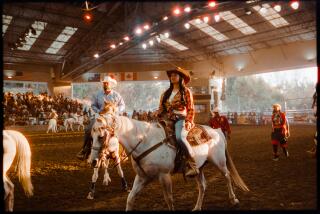Iowa Proves It’s a Big Wheel in Cycling World
- Share via
RENWICK, Iowa — It was not long after daybreak and Galen Engstrom, the town maintenance chief--actually its entire maintenance department--was up on the water tower holding a video camera instead of a wrench.
As he could see from his perch, other people were out early too, all across town. Maury and Ada Nissen were plopped in their lawn chairs on Main Street along with their toy poodle Mitzie. And 80-year-old Norma Long had ventured from her house for the first time since she broke her hip eight weeks earlier.
Not a Lazy Day
Up the street, near the gas station, Lavonne Pogge was busy setting up a snack stand and gabbing away with others in her church group. And Mary Sorenson sat on her front lawn aiming a stream of water from her garden hose across the two-lane highway.
Clearly this was not just another lazy, long, hot, July day when people pass time watching the Iowa corn grow.
The great RAGBRAI bicycle trek--an annual “Tour de Farms” with as many as 11,000 raucous riders rambling across Iowa in the biggest cycling event of its kind--was about to spin through all five blocks of Renwick. Nobody wanted to miss a minute of it.
“When you only got 450 people in town, that’s about the only thing that happens all year except the day the dog runs loose,” said Police Chief Galen Hindt.
At 5:53 a.m. the first cyclist rolled by. Maury and Ada Nissen yelled and waved.
Soon it was as if a dam had burst.
Engstrom, peering through his viewfinder, saw a trickle of riders turn to a rivulet. Then, as the sun lifted over the horizon, they became waves. Thousands of cyclists formed a fast-moving stream, rushing along miles and miles of Iowa highway blacktop. During the early morning hours, the flood tide swamped Renwick and swept past.
Awash in Cyclists
For the last week, towns from Onawa on the Missouri River all the way east to Guttenberg on the Mississippi have been awash in cyclists, so many of them that their overnight encampments unofficially qualified as Iowa’s 30th largest city.
The real towns welcomed them, entertained them, and celebrated with them. They also cashed in on the sweaty, hungry and thirsty cyclists who pedaled across this heartland state in the 437-mile endurance test that is Iowa’s answer to the Boston Marathon.
A bike trek rather than a bike race, RAGBRAI (pronounced RAG-BRAY) draws cycling enthusiasts from across the country. The biggest event between spring planting and fall harvest, it pulls Iowans out of their homes, farms and businesses by the hundreds of thousands to watch.
The trek--on a route across Iowa that is altered each year--is the longest and oldest bicycle touring ride in the world, according to its sponsor, the Des Moines Register. RAGBRAI stands for the Register’s Annual Great Bike Ride Across Iowa. With cycling rolling to a new popularity, the Iowa trek has inspired similar rides in several states from Washington to Vermont.
But it is the Iowa ride that bikers line up for.
‘Surprises Me I’m Back’
“I did half of it last year and it surprises me that I’m back,” said Susan Boeding, 28, a Minneapolis accountant. “I got thoroughly drenched, I got sick. I got sunburned and I came back for another year,” she said, resting on a grassy knoll after a day’s ride.
Kay Boyd, an Atlanta psychiatric counselor with a bright, sunburned nose, propped her head on a cycling helmet under a shady evergreen and reflected on the day’s ride. “I’m always amazed at how friendly the towns are, how patient they are,” said Boyd, who was riding in her third RAGBRAI.
“You can literally eat your way across Iowa,” said Peter Pallag, 34, a materials engineer from San Diego who shipped his bike to Iowa for the ride. “The hospitality is amazing.”
Roadsides are lined with families, church groups and entrepreneurs selling homemade snacks, lemonade and ice tea. There seems to be a stand at the top of every hill (yes, there are hills in Iowa) and around every bend. For Iowa, RAGBRAI is big business. The Des Moines Register estimates that the seven-day trek brings in about $1 million, with riders spending as much as $100,000 in some of the bigger towns.
As Much Carnival
No wonder the towns go all out, making the ride as much carnival as trek.
In Storm Lake, the overnight stop last Monday, city officials closed off Hudson Street, filled it with sand, and staged what they called “Beach Party ‘87” for their rolling guests.
Merchants in Kanawha, a mid-day stop during Wednesday’s 80-mile leg, covered the town square with an awning sewn from 72 parachutes and offered such a banquet for sale that even the most disciplined athletes could not resist the temptation to stop and nibble. The town was so jammed with bicycles and riders that the only way to travel from one end of Main Street to the other was to walk.
Renwick began stirring before dawn in anticipation of the ride. The planning committee at St. Paul Lutheran Church unwrapped the dozens of cookies, brownies and sandwiches it would eventually sell to bring in nearly $1,000 for the church expansion fund. In a somewhat different spiritual vein, Charlie’s cocktail lounge and the D.T.’s bar opened before breakfast to accommodate the first wave of revelers.
Out of Bed Early
The Nissens climbed out of bed early, as did numerous others of their neighbors, so that not a rider could slip by unseen or unwaved to. “We got so much sitting around to do, we got to get up early to get it all done,” Maury Nissen, 75, explained.
The town was clearly fascinated. Kim Swanson declared RAGBRAI “the biggest thing around here since Watermelon Days.” Arnie Black, a former mayor, hauled out his Instamatic to take pictures so he could send copies to family members.
Maureen Cameron, dressed in black because she had to go to a funeral when she got done watching the carnival, chuckled in mock agony from a bleacher section of lawn chairs she and a dozen other women had set up in a little plaza across from the D.T.’s. “My body gets sore just watching this,” she confessed.
If spectators came to see a show, they got one. One rider, determined to make a statement about the evils of tobacco, chugged across Iowa on a tandem bike with a skeleton displaying an anti-smoking message lashed to the back seat. Another lugged a tape deck blaring polka music.
Many Formed ‘Teams’
Many cyclists formed in “teams” whose names often made a statement. There were the “Wacky Wheelers,” “Team Gigolo,” “Team Charlie’s Horse,” “Team No-Knees” and “Team Me-Off,” whose members each had nicknames like “tick,” “send,” and “shove” and a number of more imaginative combinations.
There were the “Team Liars,” who sported whoppers like “free beer in the next town” on T-shirts. The “Team Whiners,” all from Michigan, rode the entire route griping about the weather, the hills, the food, the road conditions, the campsites--even about being in Iowa.
Perhaps the rowdiest group was “Team Tacky,” a pack of 31 Clinton County, Iowa, residents--including the county sheriff--who traveled the highways and byways of rural Iowa cooking up stunts to justify their name. In Palmer, so small that it does not make the official state map, five team members bared their buttocks for the town. Each had a letter carefully painted on the left cheek. In formation, they spelled T-A-C-K-Y.
Shadowing the stream of riders on a parallel route was a caravan of more than 500 trucks, including two semi-trailers, vans, campers, and other assorted vehicles hauling tents, sleeping bags and even portable showers.
Mobile Repair Shops
Other vehicles patrolled the bikers’ route, including 15 mobile bicycle repair shops, a pickup truck for weary riders and a platoon of ambulances. One rider was killed this year when he slipped under the wheels of a passing trailer, the fourth person to die in the 15-year history of the event.
RAGBRAI is, in fact, a big portable city with a portable post office, portable toilets and portable housing. Most riders choose to live in tents, turning city parks into gigantic overnight bivouacs. But as RAGBRAI has grown and attracted increasing numbers of Yuppies, accommodations have, well, changed. It is not uncommon to walk through the rows of camper vans to find couples unwinding from a tough day of pedaling sipping champagne from crystal goblets, munching Brie and watching television.
A study by an Iowa State University graduate showed that two-thirds of the riders over 18 were professional or managerial level people and that two-thirds were male. The study also found that 21% were riding with their spouses and that 25% brought children.
RAGBRAI sponsors limit the ride to 7,500 accredited bicyclists, but thousands more join without accreditation.
Trek Started in 1973
The trek began in 1973 when two Des Moines Register columnists decided to ride across the state from Sioux City to Davenport. They invited readers to join them and 300 showed up. Appeals from more readers led to a second ride in 1974 and 1,800 attended. The event has been recycled annually since.
Now so many want to be part of the ride that the Register holds a lottery to award its 7,500 spots. Half go to riders from out of state.
“We like hearing where everybody comes from,” said Art and Johanna Berkens, retired farmers who left Eagle Grove early to get a good spot on gravel County 54 where it intersects with the two-lane blacktop.
“Pretty exciting,” said Art, 64.
“Very exciting,” said Johanna, 61. “If I was younger, I’d be out there myself.”
More to Read
Sign up for Essential California
The most important California stories and recommendations in your inbox every morning.
You may occasionally receive promotional content from the Los Angeles Times.













